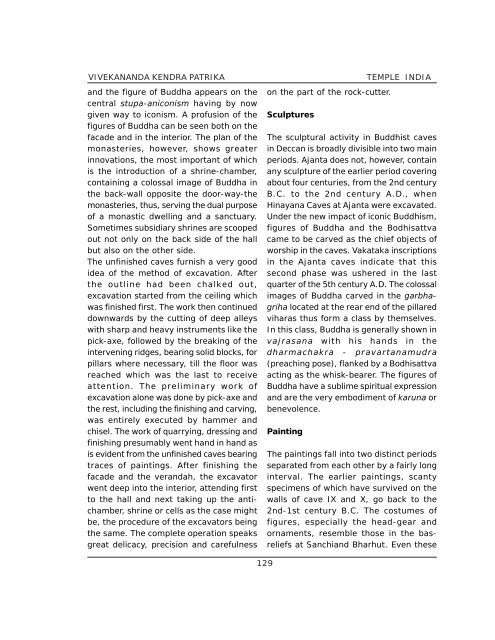Temples In India-1.pdf - Vivekananda Kendra Prakashan
Temples In India-1.pdf - Vivekananda Kendra Prakashan
Temples In India-1.pdf - Vivekananda Kendra Prakashan
Create successful ePaper yourself
Turn your PDF publications into a flip-book with our unique Google optimized e-Paper software.
VIVEKANANDA KENDRA PATRIKAand the figure of Buddha appears on thecentral stupa-aniconism having by nowgiven way to iconism. A profusion of thefigures of Buddha can be seen both on thefacade and in the interior. The plan of themonasteries, however, shows greaterinnovations, the most important of whichis the introduction of a shrine-chamber,containing a colossal image of Buddha inthe back-wall opposite the door-way-themonasteries, thus, serving the dual purposeof a monastic dwelling and a sanctuary.Sometimes subsidiary shrines are scoopedout not only on the back side of the hallbut also on the other side.The unfinished caves furnish a very goodidea of the method of excavation. Afterthe outline had been chalked out,excavation started from the ceiling whichwas finished first. The work then continueddownwards by the cutting of deep alleyswith sharp and heavy instruments like thepick-axe, followed by the breaking of theintervening ridges, bearing solid blocks, forpillars where necessary, till the floor wasreached which was the last to receiveattention. The preliminary work ofexcavation alone was done by pick-axe andthe rest, including the finishing and carving,was entirely executed by hammer andchisel. The work of quarrying, dressing andfinishing presumably went hand in hand asis evident from the unfinished caves bearingtraces of paintings. After finishing thefacade and the verandah, the excavatorwent deep into the interior, attending firstto the hall and next taking up the antichamber,shrine or cells as the case mightbe, the procedure of the excavators beingthe same. The complete operation speaksgreat delicacy, precision and carefulnesson the part of the rock-cutter.SculpturesTEMPLE INDIAThe sculptural activity in Buddhist cavesin Deccan is broadly divisible into two mainperiods. Ajanta does not, however, containany sculpture of the earlier period coveringabout four centuries, from the 2nd centuryB.C. to the 2nd century A.D., whenHinayana Caves at Ajanta were excavated.Under the new impact of iconic Buddhism,figures of Buddha and the Bodhisattvacame to be carved as the chief objects ofworship in the caves. Vakataka inscriptionsin the Ajanta caves indicate that thissecond phase was ushered in the lastquarter of the 5th century A.D. The colossalimages of Buddha carved in the garbhagrihalocated at the rear end of the pillaredviharas thus form a class by themselves.<strong>In</strong> this class, Buddha is generally shown invajrasana with his hands in thedharmachakra - pravartanamudra(preaching pose), flanked by a Bodhisattvaacting as the whisk-bearer. The figures ofBuddha have a sublime spiritual expressionand are the very embodiment of karuna orbenevolence.PaintingThe paintings fall into two distinct periodsseparated from each other by a fairly longinterval. The earlier paintings, scantyspecimens of which have survived on thewalls of cave IX and X, go back to the2nd-1st century B.C. The costumes offigures, especially the head-gear andornaments, resemble those in the basreliefsat Sanchiand Bharhut. Even these129
















